
Oil from the BP spill covers a beach in Louisiana on Thursday May 20th
John McCusker / Times-Picayune

There was a very diverse mix of people there. Maria Simani, who invited me, works at the Alpha Center at UCR, connecting UCR faculty to K-12 teachers. Rusty Russell is a botany collections manager for the Smithsonian, who has worked on mapping climate change in the San Jacinto Mountains with the help of geographic information systems (or "GIS") technology.
Some people were from ESRI, which is an leading company when it comes to GIS technology. Charles Convis leads the ESRI conservation program and knows a lot about citizen science. When I told him that I want to interview mathematicians working on environmental projects, he mentioned Abel Wohlman, a mathematician at Johns Hopkins who works on conservation planning, and Steve Kelling at Cornell Laboratory of Ornithology, who has extended John Tukey's exploratory data analysis techniques to deal with the occasional unreliability of data sets produced by citizen scientists.
Sean
Lahmeyer works at the Huntington Garden Herbarium and is getting
people in Pasadena to map the Arroyo Seco area. Jennifer Futterman
of the Coachella Valley school district has been working on replacing
their science curriculum with one that incorporates ecology.
Kim McNulty runs the Career Pathways Initiative for Coachella Valley
high schools.
May 10, 2010
It looks like I'll be getting another year of leave from UCR, so I can
stay in Singapore for two years! Lisa already got her second year of
leave approved, but I just heard my leave will be approved too.
May 17, 2010
Today is Monday, the beginning of a fun and busy fortnight.
Tomorrow at 6:30 am, Lisa and I are taking Lucky Shuttle — a Chinese-run shuttle service — to the Los Angeles airport. She's going on a long trip to Montreal, Erlangen, Glasgow, back to Montreal and then back home. I'm going first to New York and then to Oxford, returning on May 31st. In New York on Wednesday morning I'll teach Dennis Sullivan's "Intermediate Algebraic Topology" course at the CUNY Graduate Center, and then give a talk on electrical circuits at his seminar. On Thursday we'll go to Stony Brook and I'll talk about Categorification in Topology at the topology seminar. I'll hang out for a couple more days, and on Saturday night — if the volcano permits — I'll fly to Oxford.
My flight is supposed to arrive at 10:30 am on Sunday May 23rd. I'll take the Airline (a one-hour bus ride) to Oxford and go to the Cotswold Lodge. Then from May 24th to 28th I'll attend the school on Foundational Structures in Quantum Computation and Information, run by Bob Coecke and Ross Duncan. I plan to talk to Tim Palmer over lunch on Tuesday the 24th, Thomas Fischbacher on Thursday the 27th starting at 12:00, and also Dan Ghica. On Friday afternoon, Eugenia Cheng and Alissa Crans are supposed to show up, and we'll have a big discussion on category and n-category theory with people including Bruce Bartlett, Simon Willerton and Jamie Vicary.
On Saturday I'll give a talk on Duality in
Logic and Physics at the Quantum
Physics and Logic workshop organized by Bob Coecke,
Prakash Panangaden, and Peter Selinger. Louis Crane will give
a talk there too, and John Barrett should be there as well.
The workshop goes on until Sunday. And then — if the volcano
permits — I'll catch a flight
from Heathrow to Los Angeles at 3:45 pm on Monday May 31st.
May 21, 2010
Well, on Wednesday it turned out that Dennis Sullivan's
"Intermediate Algebraic Topology" course is really just a seminar
where
he and his visiting speakers talk about their latest ideas. There is
no "Advanced Algebraic Topology" course.
I saw a bunch of faces familiar from my last visit, and some new ones, like Aron Fischer and Kate Poirier. He'd prepared a list of questions for me which pretty much matched what I wanted to do: give a nontechnical introduction to n-categories and their applications to topology. I was momentarily afraid that my usual spiel would be too elementary for this crowd, but I tend to forget that most people are not working on n-categories and don't have an intuitive feel for them. So, I tried to give them that feel from 11 until about 1.
Then we had lunch — vegetarian sandwiches and salad were carted in. Mikhail Khovanov showed up, which was a nice surprise, and I launched into my talk about categories whose morphisms are electrical circuits. Starting from basics like Kirchhoff's laws and Ohm's law I led up to the description of circuits made of resistors in terms of chain complexes, and then their description in terms of Dirichlet forms and Lagrangian subspaces — with the last allowing us to describe wires of zero resistance, as needed for a well-behaved category. We had a coffee break and then Dennis had to leave at 4 pm. The excitement level dropped without his trademark probing questions, but the rest of the audience manfully did their best to do that job, and we went on until 6:30. We had dinner at a Persian restaurant.
On Thursday I took the train to Stony Brook with Kate and Aron. After chatting a bit with Sasha Kirillov, who is working on describing the Turaev-Viro model as an extended TQFT, and listening a bit to Dennis and Kate talk about string topology and compactifications of moduli space, I gave a one-hour slide talk on categorification in topology. Then a bunch of us had lunch, including Oleg Viro. It was nice to see him again... he used to teach at UCR.
Then we took the long train ride back, and then I more or less collapsed: first a nap, and then a long session of goofing off.
In a little while I'll take the F train down to the CUNY Graduate Center
and talk to Mahmoud Zeinalian, a former student of Dennis who is working on
E(n) algebras and some generalizations of Hochschild homology. Then I'll meet
Khovanov at noon and take the Q train to Chinatown, for lunch.
All this meeting people and zipping around on trains and subways is very
unlike my life in Riverside.
May 22, 2010
I had dinner last night with Mahmoud Zeinalian, his wife Heleike, and some
friends. Mahmoud pointed me to this:
By the way: yesterday Dennis Sullivan urged me to contact Mary-Lou Zeeman, a professor of mathematics at Bowdoin College who talks about how mathematicians can help tackle climate change and sustainability issues:
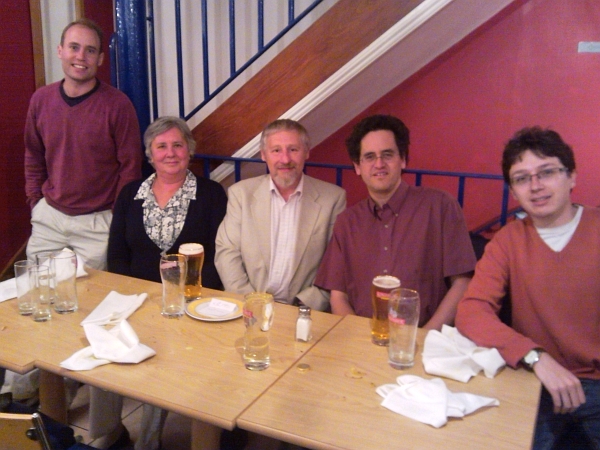
From left to right: Bruce Bartlett, Alison, Oz, me, and
Jamie Vicary.
May 28, 2010
On Friday,
after the end of the week-long school on Foundational Structures in Quantum Computation and Information and before the Quantum Physics and Logic conference
started, Alissa Crans, Eugenia Cheng, Richard Garner and Simon
Willerton showed up in Oxford. This called for a bit of celebration. Luckily
Bob Coecke has established a tradition called the 'Quantum Whisky Club', which
takes place intermittently at the Computing Lab... and that tradition
provided the necessary infrastructure for a proper celebration. At 9:30 a
bunch of people started started living it up. At Bob's demand, I did a little
live blogging to document the event. But nothing too indiscreet.
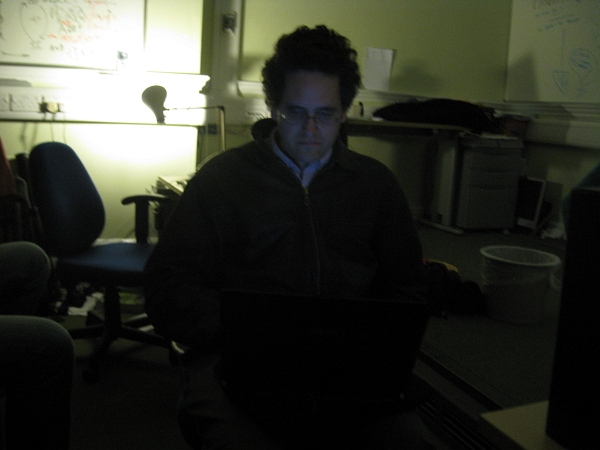
Below from left to right you can see Eugenia Cheng's foot (if you look incredibly hard, that is), and then Alissa Crans leaning on the windowpane, and then the mysterious black silhouette of Andrei Akhvlediani, who is facing away, in front of the glare of a desk lamp. Then comes Richard Garner basking in the golden glow of light at the edge of a curtain, and then, in front of him — much easier to see! — Aleks Kissinger cheerily holding his cup high, and Philip Atzemoglou way in back, and me happily blogging away on my laptop...
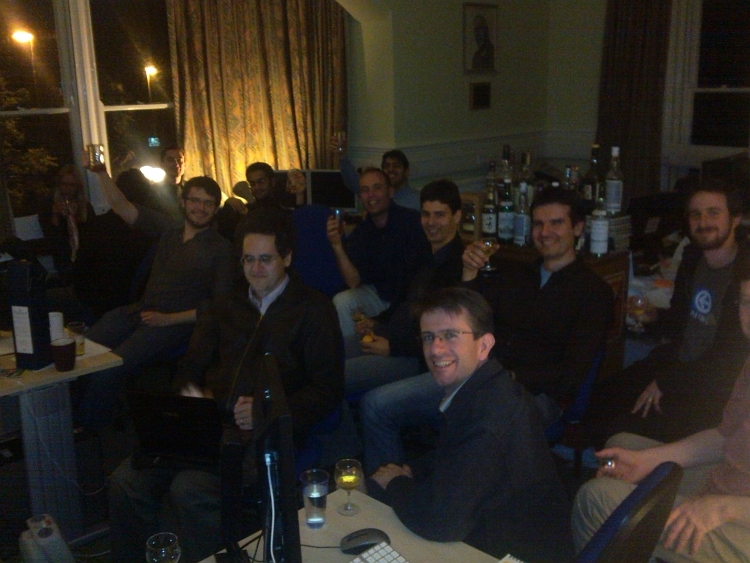
...and then Bruce Bartlett, and Ray Lal behind him way in back, and Chris Heunen, Simon Willerton right up front, then Andreas Döring grinning and holding a glass, Ross Duncan, and just a tiny bit of Bertfried Fauser on the right-hand edge of the photo. Present but invisible are Nadja Kutz... and the fellow taking this picture: Jamie Vicary.
I also met Jacob Biamonte, who will be visiting the Centre for Quantum Technologies in Singapore starting this summer. Among many other things, he said:
I mentioned some projects related to energy in Boston listed here - don't think the quantum bio stuff is mentioned here. This was work Alán Aspuru-Guzik did studying light harvesting complexes which were shown to use quantum coherence (like a search algorithm) to enhance photon consumption. The future idea they have is to use related ideas to create better solar panels. In just a few weeks, I will go to Alan's workshop on Quantum Bio.
Jacob introduced me to some other people from Oxford who will also
be visiting the CQT during my stay there: notably, Dieter Jaksch (who works on ultra-cold physics
such as optical lattices and Bose-Einstein condensates, and their applications
to quantum information processing) and Vlatko Vedral (who works on quantum information). It was
great getting some sense of who I'll be seeing when I go to Singapore
next month.
May 30, 2010
On Sunday, John Barrett and Louis Crane gave talks on quantum gravity.
John is trying to use 3-categories to understand matter in 3d quantum
gravity, and 4-categories to understand matter in 4d quantum gravity.
The first part definitely works; the second part is speculative.
I talked to both of them at lunch in the graveyard near the Computing
Lab:

From left to right, facing the camera, here are Bruce Bartlett, Peter Selinger, Jamie Vicary, and Chris Heunen talking things over at that same lunch:
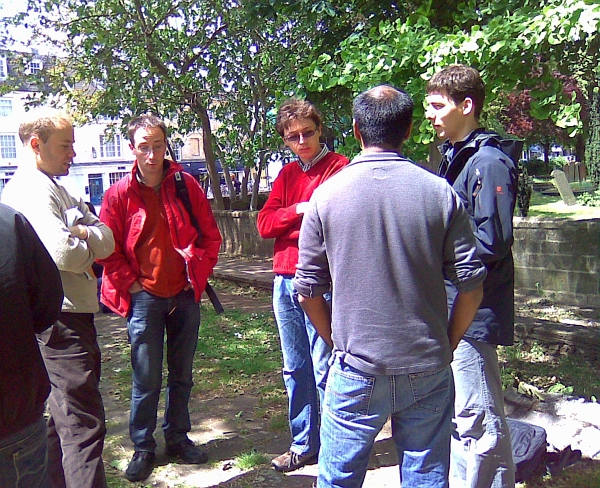
Facing away is Sanjeevi Krishnan.
Around 5 pm, Louis gave the last talk of the workshop. He's trying to use rational homotopy theory and related ideas from model category theory to better understand state sum models of quantum gravity. Here he is, standing in front of an impressively tall blackboard containing both his notes and the pictures from John Barrett's earlier talk:
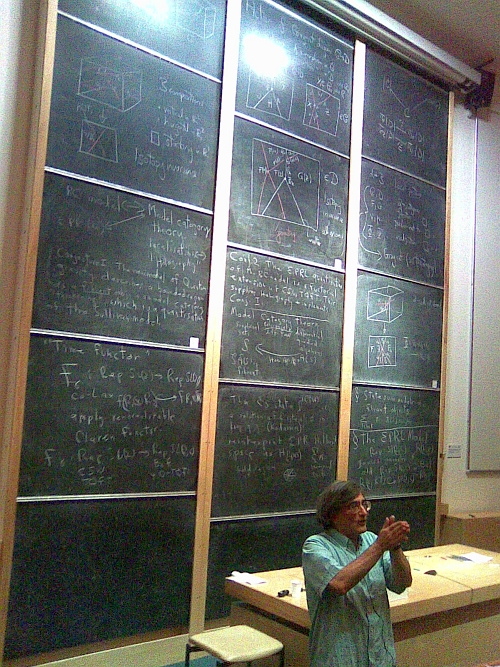
Later, John Barrett took the train home. A bunch of us had dinner... And then, late on Sunday night, my last night in Oxford, there was a smaller but more energetic meeting of the Quantum Whisky Club. Dancing!
May 31, 2010
I flew back to Los Angeles without incident.
I haven't been writing much about the BP oil spill in the Gulf of Mexico, because you could read it in the news... or books, if you're in my future. I think Obama was right: it's "enraging as it is heartbreaking".
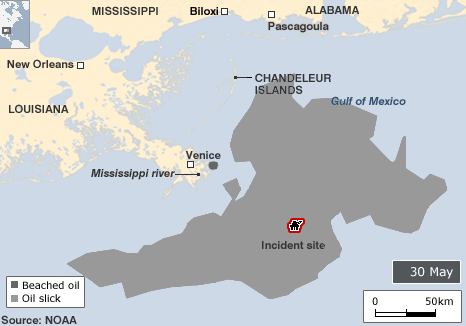
BP initially estimated that the wellhead was leaking 1,000 barrels a day. On April 28, the National Oceanic and Atmospheric Administration estimated that the leak was likely 5,000 barrels a day. On May 27, 2010 the US government increased its official estimate to 12,000-19,000 barrels a day.
Later some scientists involved in this estimate said that these numbers were intended only as a lower bound! On June 10th Marcia McNutt, head of a group of scientists called the Flow Rate Technical Group, listed several estimates in the range of 20,000 to 40,000 barrels a day — that is, before the top of the wellhead was cut and a pipe was installed that caught some (but not all) of the oil. Different methods give different estimates.
Not many of us have a sense for "barrels", so maybe it will help to say that 20,000 to 40,000 barrels of oil is 840,000 to 1,680,000 US gallons, or 3,200,000 to 6,400,000 litres. Or maybe not. It's hard to get a sense for that much oil. Maybe some comparisons would be better.
The Exxon Valdez oil spill released a total of 250,000 barrels of oil. As of June 10th, people were saying that the current disaster was at least 4 times as big.
But in fact the Exxon Valdez was not one of the world's largest oil spills. The largest was about 40 times bigger: 10,000,000 barrels were spilled in the Gulf War oil spill. This spill was deliberately created by Saddam Hussain in 1991, apparently to prevent US Marines from landing. It reached a size of about 6800 square kilometers. Dr. Hans-Jörg Barth, a German geographer, wrote a report on the impact a decade later. He wrote:
The study demonstrated that, in contrary to previously published reports e.g. already 1993 by UNEP, several coastal areas even in 2001 still show significant oil impact and in some places no recovery at all. The salt marshes which occur at almost 50% of the coastline show the heaviest impact compared to the other ecosystem types after 10 years. Completely recovered are the rocky shores and mangroves. Sand beaches are on the best way to complete recovery. The main reason for the delayed recovery of the salt marshes is the absence of physical energy (wave action) and the mostly anaerobic milieu of the oiled substrates. The latter is mostly caused by cyanobacteria which form impermeable mats. In other cases tar crusts are responsible. The availability of oxygen is the most important criterion for oil degradation. Where oil degrades it was obvious that benthic intertidal fauna such as crabs re-colonise the destroyed habitats long before the halophytes. The most important paths of regeneration are the tidal channels and the adjacent areas. Full recovery of the salt marshes will certainly need some more decades.
© 2010 John Baez
baez@math.removethis.ucr.andthis.edu